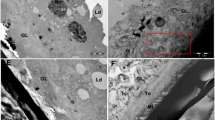Abstract
Visceral toxocariasis is a serious public health problem with a cosmopolitan distribution. Children are susceptible due to their immature immune system and high risks of infection. Nevertheless, the few completed studies about immunosuppression have had controversial results. To evaluate the effect of two immunosuppressive drugs on the larval burden of Toxocara canis, four groups of ten Swiss strain mice each were inoculated on day 0 with 1,200 embryonated T. canis eggs. Fifteen days before the experimental infection, group 1 (control) was treated via intraperitoneal injection (IP) with sterile distilled water and groups 2 and 3 were treated with dexamethasone (DEX) at 1 and 5 mg/kg/day, respectively. Additionally, group 4 was treated IP with cyclophosphamide (CY) at 50 mg/kg at two times per week for 2 weeks. Sixty days following infection, the mice were euthanised to recover the larvae by means of the tissue digestion technique. The levels of antibodies detected by indirect ELISA were not associated with the larval burden. Administration of CY (50 mg/kg) and DEX (5 mg/kg) resulted in an increase of the larval burden of 162.1% and 50.8%, respectively, in relation to the control group. These two treatments, especially CY (50 mg/kg), promoted immunosuppression and the establishment of a significant larval burden, supporting its further utilisation in studies related to immunosuppression in visceral toxocariasis.


Similar content being viewed by others
References
Corrêa EB, Cunha JMT, Bunn-Moreno MM, Madeira ED (1992) Cyclophosphamide affects the dynamics of granuloma formation in experimental visceral leishmaniasis. Parasitol Res 78:154–160
De Savigny DH (1975) In vitro maintenance of Toxocara canis larvae and a simple method for the production of Toxocara ES antigens for use in serodiagnostic tests for visceral larva migrans. J Parasitol 61:781–782
Dunsmore JD, Thompson CA, Bates IA (1983) The accumulation of Toxocara canis larvae in the brains of mice. Int J Parasitol 13:517–521
EL-Ganayni G, Handousa A (1992) The effect of cyclosporin A (CSA) on murine visceral toxocariasis canis. J Egypt Soc Parasitol 22:487–494
Figueiredo SDP, Taddei JAAC, Menezes JJC, Novo NF, Silva EOM, Cristovão HLG, Cury MCFS (2005) Estudo clínico-epidemiológico da toxocaríase em população infantil. J Pediatr 81:126–132
Glickman LT, Schantz PM, Cypess RH (1979) Canine and human toxocariasis: review of transmission, pathogenesis, and clinical disease. J Am Vet Med Assoc 175:1265–1269
Habluetzel A, Traldi G, Ruggieri S, Attili AR, Scuppa P, Marchetti R, Menghini G, Esposito F (2003) An estimation of Toxocara canis prevalence in dogs, environmental egg contamination and risk of human infection in the Marche region of Italy. Vet Parasitol 113:243–252
Hayashi E, Tuda J, Imada M, Akao N, Fujita K (2005) The high prevalence of asymptomatic Toxocara infection among schoolchildren in Mamado, Indonesia. Southeast Asian J Trop Med Public Health 36:1399–1406
Kang KM, Choi I, Shin DW, Lee YH (2006) Cytokine and antibody responses of reactivated murine toxoplasmosis upon administration of dexamethasone. Korean J Parasitol 44:209–219
Katz SP, Lammie PJ (1984) Effect of cyclophosphamide on the immune responsiveness of jirds infected with Brugia pahangi. Infect Immun 43:753–755
Kayes SG (1997) Human toxocariasis and the visceral larva migrans syndrome: correlative immunopathology. Chem Immunol 66:99–124
Lallo MA, Bondan EF (2005) Experimental meningoencephalomyelitis by Encephalitozoon cuniculiin cyclophosphamide-immunosuppressed mice. Arq Neuropsiquiatr 63:246–251
Lallo MA, Santos MJ, Bondan EF (2002) Infecção experimental pelo Encephalitozoon cuniculi em camundongos imunossuprimidos com dexametasona. Rev Saude Publica 36:621–626
Lescano SZ, Chieffi PP, Neto VA, Ikai DK, Ribeiro MCS (2004) Efeitos da ciclosporina A e betametasona na toxocaríase murina experimental. Rev Soc Bras Med Trop 37:22–24
Norbiato G, Bevilacqua M, Vago T, Taddei A, Clerici M (1997) Glucocorticoids and the immune function in the human immunodeficiency virus infection: a study in hypercortisolemic and cortisol-resistant patients. J Clin Endocrinol Metab 82:3260–3263
Paludo ML, Falavigna DLM, Elefant GR, Gomes ML, Baggio MLM, Amadei LB, Falavigna-Guilherme AL (2007) Frequency of Toxocara infection in children attended by the health public service of Maringá, South Brazil. Rev Inst Med Trop Sao Paulo 49:343–348
Rynda A, Maddaloni M, Mierzejewska D, Ochoa-Repáraz J, Maslanka T, Crist K, Riccardi C, Barszczewska B, Fujihashi K, McGhee JR, Pascual DW (2008) Low-dose tolerance is mediated by the microfold cell ligand, reovirus protein {sigma}1. J Immunol 180:5187–5200
Smith H, Noordin R (2006) Diagnostic limitations and future trends in the serodiagnosis of human toxocariasis. In: The enigmatic parasite. CABI Publishing, UK pp. 89–112
Smith H, Holland C, Taylor M, Magnaval JF, Schantz P, Maizels R (2009) How common is human toxocariasis? Towards standardizing our knowledge. Trends Parasitol 25:182–188
Torina A, Caracappa S, Barera A, Dieli F, Sireci G, Genchi C, Deplazes P, Salerno A (2005) Toxocara canis infection induces antigen-specific IL-10 and IFNγ production in pregnant dogs and their puppies. Vet Immunol Immunopathol 108:247–251
Verdon R, Polianski J, Grodets A, Garryt L, Carbon C (1998) Cryptosporidium parvum biliary tract infection in adult immunocompetent and immunosuppressed mice. J Med Microbiol 47:71–77
Wang GX, Luo ZJ (1998) A novel method for the recovery of Toxocara canis in mice. J Helminthol 72:183–184
Won KY, Kruszon-Moran D, Schantz PM, Jones JL (2008) National seroprevalence and risk factors for zoonotic Toxocara spp. infection. Am J Trop Med Hyg 79:552–557
Acknowledgements
Thanks to the laboratory technician Lourdes Helena Martins for collaboration in this study, to the Post-Graduate Program in Public Health for support and the Coordenação de Aperfeiçoamento de Pessoal de Nível Superior (CAPES) for the scholarship grant for studies. The experiments were carried out following the Federal Government legislation on animal care.
Author information
Authors and Affiliations
Corresponding author
Rights and permissions
About this article
Cite this article
da Costa de Avila, L.F., da Fonseca, J.S.V., Dutra, G.F. et al. Evaluation of the immunosuppressive effect of cyclophosphamide and dexamethasone in mice with visceral toxocariasis. Parasitol Res 110, 443–447 (2012). https://doi.org/10.1007/s00436-011-2510-5
Received:
Accepted:
Published:
Issue Date:
DOI: https://doi.org/10.1007/s00436-011-2510-5




